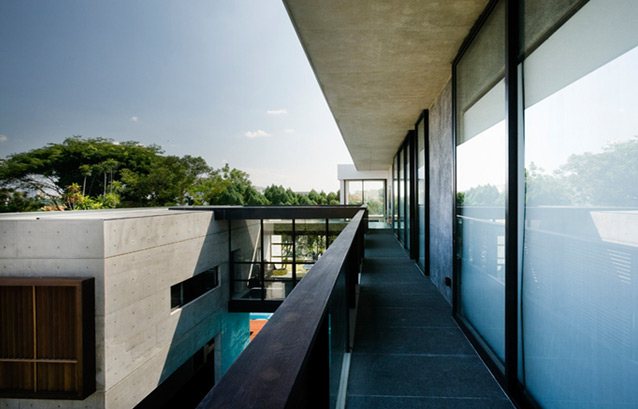
The Apartment House designed by Formwerkz Architects is a design that started out being a collection of ‘apartments’ for a multi-generational family, and ended up as a contemplative exploration between art and architecture. While conceived as a large house, the end result is more akin in spirit to famous houses that have borne the incremental and lasting imprint of their illustrious occupants, such as Ruskin’s Brentwood in the Lake District, or Jefferson’s Monticello in Virginia. It was the case of the inhabitant fitting the habitat to the core.

There is an element of destiny in this, in that the architects are long-time friends of the client, Chua Koon Beng, an artist that they have known since their university days. Although the house is neatly compartmentalised to cater to the needs of what is in effect four families (Koon Beng’s parents and two siblings as well as that of his own family and personal art studio), it was Koon Beng who represented the clan in many of the design discussions that have shaped the tectonic qualities in and out of the house. Not only was he involved with the minute details such as the design of a light pendant or a clothes-hanging rack, his paintings are the exclusive artworks in the major junctions of the house; along its corridors, and on all walls that enclose the spiral staircase. There are also some recycled pieces from his installation works that have been refitted as benches or artworks on the walls of the living and dining areas. On the ground level, his studio fronts the house, and enjoys what is easily the most welcoming indoor/outdoor space of the compound.

This does not in any way deflate the significance of Formwerkz Architects’ work and mastery of the architectural forms for the house, but the stage was set for a project where they knew they had a client with a cultivated taste in design, and once the macro framework of the design has been set, the process became more fluid and collaborative. Since its founding in 1998, Formwerkz Architects have garnered a reputation for being able to succinctly illustrate the client’s complex agenda with programmatic clarity. There is an additive quality to their architecture, of blocks coming together in Lego-like formations that strike a balance between monumentality and intimacy. This can be seen in how they have organized the Apartment House into separate modules that contain their own entrances, spiral staircases (there are four staircases in the house), jacuzzi pools (also four) and pantries, even as they share the major communal living and dining spaces. The modules are then personalised to the particular needs of the occupants – a gaming room for the parents, a home-office for the sister, a gym for the brother and so on. A major determinant of the design was the early decision to allow for a time in the future when the regular site can be sub-divided into two separate plots of land. This lent itself to a layout with two wings that are split by a swimming pool and a bridging floor that supports a family room. The two rectilinear wings are unequal halves; one is a shorter 2-storey block of raw concrete with an impressive 6-metre cantilever, while the other maximises its land-use, touches 3 storeys and is attired in a more eclectic mix of Shanghai plaster, timber screen, travertine, painted plaster and concrete. Though less obviously, the longer wing is also possessed of an impressive structural feat, in that a heavy concrete wall is suspended over the pool and half conceals the main staircase. The two wings are aligned almost entirely along the east-west axis, thereby minimising the facades’ exposure to the sun. Greenery moderates the hardness of the straight-edge materials in the form of green walls and landscaped roof. A reflective pool tops over the family room that bridges the two wings.
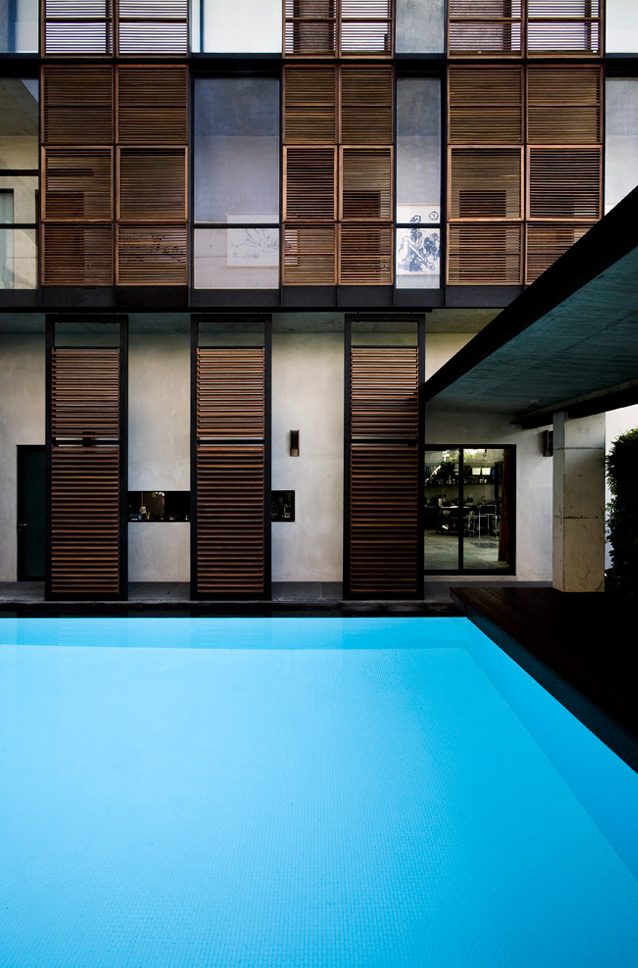
Even with these basic parameters of the formal design set, lead architect Seetoh Kum Loon concedes that the Apartment House is unique in their oeuvre not only for its “complex narrative”, but also because it is a design that is “progressively sculpted on site”. The construction took well over two years, unusually long for a house built in fast-paced Singapore, but this has allowed for exhaustive involvement from Koon Beng and even the Indian construction foreman on site. “Most details and materials were changed and confirmed throughout the construction process to capture whatever opportunities that were revealed and presented to us along the way,” said Seetoh.
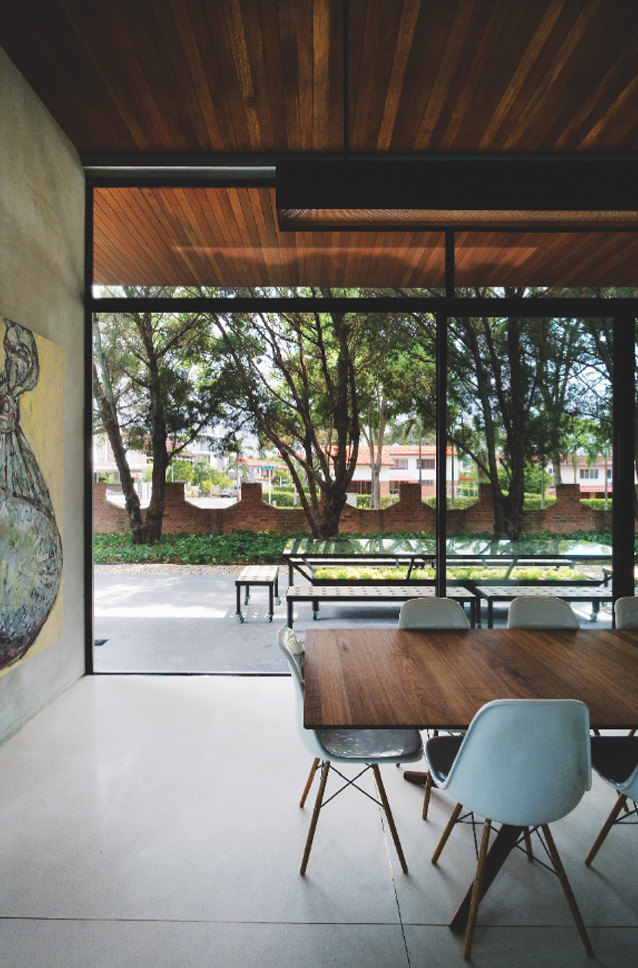
An example of these improvisational details is the existing wall that fences the back of the house. Meant to be demolished altogether, the plan was changed when the original ceramic finish was chipped off to reveal the rusticated grain of the brick beneath. Six workers were then tasked to delicately chip away only the ceramic cover for the remainder of the fence. Another example is the new sliding gate incorporating a collapsible gate within its frame. Originally designed as fixed angle bars slanted randomly, the result would have been a gate that blocked the view of the green creeper walls viewed from inside the house when the gate is slid open. This was then changed into an accordion gate-within-a-gate, retracted when the sliding gate is parked behind the green wall.
Throughout the house, there is a recurring feature of movable parts, of things that swivel and slide. The car porch designed by Koon Beng is a light-framed steel apparatus that is supported by wheels. It can be moved to shade the cars individually or be removed totally. Custom-made tables rest on castors. Sliding partitions of steel mesh double up as a surface to hang hooks, which holds all sorts of bags and articles.
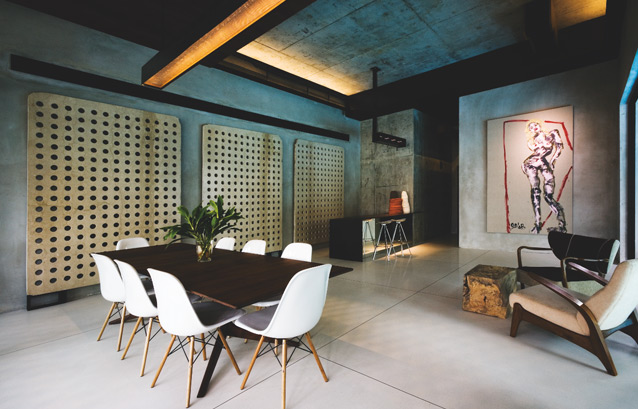
In a good way, there is an ambiguity of who has contributed to the design of the interiors. Most of the custom-made furniture and fitments were sketched out by Seetoh, but there is also a guiding philosophy evident in the fact that materials are to be left in the natural state. Many of the rooms have no ceiling and the window frames go up to the underside of the slab. Where ceilings were hung, they are of perforated metal, painted black or raw timber strips. Walls of the bedrooms are of cement or unpainted plaster. Kitchen tables are smoothened concrete and the swimming pool mosaic is a sterile white. Like the black and white nude paintings of Koon Beng that line the walls, there is austere quality to the settings, of figures and places made timeless because they are unadorned by fashion. It is almost as if the house has become the perfect receptacle for the artist and his works.
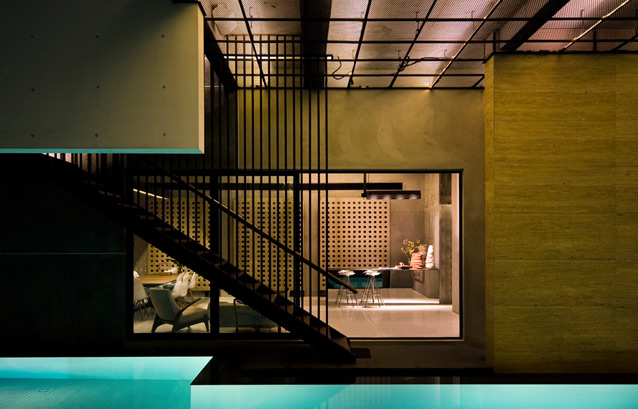
The Apartment House has reinforced Seetoh’s belief that “the design process does not end with the issuance of the construction drawings.” Indeed, while touring the house with him and Koon Beng long after post-occupation, I got the sense that in all likelihood, the house is evolving still, and the cliché that a house can define the identity of its owner is none the truer than here.
ARCHITECTS
PHOTOGRAPHY
San Tzer Ning Jeremy/ Stzern Studio

